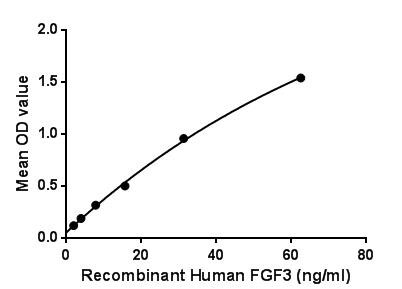Active Fibroblast Growth Factor 3 (FGF3)
HBGF3; INT2; Heparin-binding growth factor 3; Murine Mammary Tumor Virus Integration Site(v-int-2)Oncogene Homolog; INT-2 Proto-Oncogene Protein; Proto-oncogene Int-2
- Product No.APC906Hu01
- Organism SpeciesHomo sapiens (Human) Same name, Different species.
- Buffer Formulation100mMNaHCO3, 500mMNaCl, pH8.3, containing 1mM EDTA, 1mM DTT, 0.01% SKL, 5% Trehalose and Proclin300.
- TraitsFreeze-dried powder
- Purity> 90%
- Isoelectric Point11.0
- ApplicationsCell culture; Activity Assays.
- Download Instruction Manual
- UOM 10µg50µg 200µg 1mg 5mg
-
FOB
US$ 211
For more details, please contact local distributors!US$ 528
For more details, please contact local distributors! US$ 1056
For more details, please contact local distributors! US$ 3168
For more details, please contact local distributors! US$ 7920
For more details, please contact local distributors!
ACTIVITY TEST of the Active Fibroblast Growth Factor 3 (FGF3)

Fibroblast Growth Factor 3 (FGF3) also known as INT-2 proto-oncogene protein is a member of the fibroblast growth factor family. FGF family members possess broad mitogenic and cell survival activities and are involved in a variety of biological processes including embryonic development, cell growth, morphogenesis, tissue repair, tumor growth and invasion. Besides, Fibroblast Growth Factor Receptor 2 (FGFR2) has been identified as an interactor of FGF3, thus a binding ELISA assay was conducted to detect the interaction of recombinant human FGF3 and recombinant human FGFR2. Briefly, FGF3 were diluted serially in PBS, with 0.01% BSA (pH 7.4). Duplicate samples of 100μL were then transferred to FGFR2-coated microtiter wells and incubated for 2h at 37℃. Wells were washed with PBST and incubated for 1h with anti-Fibroblast Growth Factor Receptor 2 (FGFR2) pAb, then aspirated and washed 3 times. After incubation with HRP labelled secondary antibody, wells were aspirated and washed 3 times. With the addition of substrate solution, wells were incubated 15-25 minutes at 37℃. Finally, add 50µL stop solution to the wells and read at 450nm immediately. The binding activity of FGF3 and FGFR2 was shown in Figure 1, and this effect was in a dose dependent manner.
Figure. The binding activity of FGF3 with FGFR2.
USAGE of the Active Fibroblast Growth Factor 3 (FGF3)
Reconstitute in ddH2O to a concentration of 0.1-1.0 mg/mL. Do not vortex.
STORAGE of the Active Fibroblast Growth Factor 3 (FGF3)
Avoid repeated freeze/thaw cycles. Store at 2-8°C for one month. Aliquot and store at -80°C for 12 months.
STABILITY of the Active Fibroblast Growth Factor 3 (FGF3)
The thermal stability is described by the loss rate. The loss rate was determined by accelerated thermal degradation test, that is, incubate the protein at 37°C for 48h, and no obvious degradation and precipitation were observed. The loss rate is less than 5% within the expiration date under appropriate storage condition.
INCREMENT SERVICES
BCA Protein Quantification Kit
Molecular Mass Marker for Protein
Monoclonal Antibody Customized Service
Polyclonal Antibody Customized Service
Protein Activity Test Experiment Service
Electrophoretic Mobility Shift Assay (EMSA) Experiment Service
Buffer
Lentivirus Packaging Experiment Service
Adenovirus Packaging Experiment Service
Real Time PCR Experimental Service
Spike RBD Protein (S-RBD)
Protein G
Protein A

